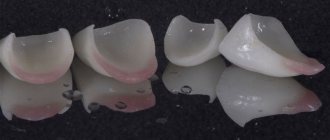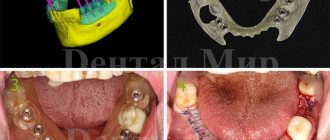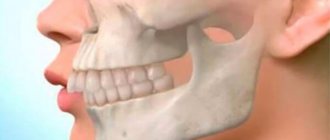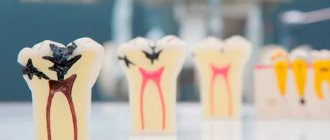Today, one of the most popular methods of correcting teeth and restoring tooth enamel is installing veneers. Veneers are thin plates that are placed on the front of the tooth. This method can make a smile graceful, hiding existing imperfections. The most important preparatory stage in installing veneers is the choice of material from which the structure will be made.
Materials for making veneers
Ceramics. Among the advantages of ceramic veneers, it is worth highlighting their high strength, which can be compared with the strength of a real tooth. Porcelain veneers are made in a dental laboratory from a previously taken impression. Ceramic veneers have a natural appearance that can be absolutely identical to other teeth. Also, the most important advantage of such veneers is their long service life. Ceramic veneers are resistant to food dyes and retain their color and shine for a long time. The disadvantages of ceramic veneers include the need to file away an impressive layer of hard tissue, which can result in weakened teeth.
Composite material. Along with ceramic, composite veneers are a very popular option for correcting tooth shape. However, veneers made from composite materials do not require cutting down tooth enamel, which is a huge advantage. One of the varieties of composite veneers are direct veneers, the distinctive feature of which is the construction of the structure directly in the patient’s mouth. The disadvantages of composite veneers include the possibility of aesthetic defects and partial loss of color and shine after several years. However, the cost of veneers made from composite materials is the most affordable.
Lumineers. This type of veneers is particularly thin. The advantages of lumineers are the preservation of tooth enamel without negative effects on it, as well as the ability to remove the structure at any time. Due to their quality characteristics, lumineers are also called “Hollywood” veneers.
Computer modelling
This technology makes it possible to make overlays in the shortest possible time directly in the presence of the patient.
True, this can only be realized if dentistry is equipped with expensive, latest technology. A 3D scanner is used to produce the model. Using a specialized program, the computer models the shape of the prosthesis and transmits data directly to a milling device, on which a veneer is milled from a conventional block of ceramic material within ten minutes. Dental veneers are ground, glazed in an oven without a vacuum, painted if necessary, and fixed to the tooth.
A similar method for producing veneers can also be applied remotely. The doctor prepares the tooth and mails the resulting optical impression to the dental laboratory, where the veneer is made and sent to dentistry.
The main advantage of the presented technology is that milling, fitting and fixation of dentures on the teeth can be done in one go.
Today, computer modeling is especially often used in the manufacture of zirconium plates, which are considered the most reliable and prestigious of all.
Methods for making veneers
Application in layers. This method involves carefully pressing platinum foil onto the prepared tooth and layer-by-layer application of the ceramic composition. To avoid the risk of shrinkage and distortion, the foil fixes the finished solution by firing. The layer-by-layer application method is the least expensive.
Casting method. This method involves making a wax overlay on a plaster model and covering it with a special glass-ceramic composition. The structure is placed in a refractory mass, the wax is melted and burned out, after which the mass is removed. The final stage of the casting method is painting the veneers in a color identical to the patient’s tooth enamel and grinding. The great advantage of the casting method is the possibility of obtaining an aesthetic effect and structural strength.
Computer modeling method (using CAD/CAM technologies). This method of making veneers involves obtaining a digital model of the ground and adjacent teeth using a 3D scanner. Modeling of microprostheses is performed in a special computer program, after which technicians produce the design itself within 3-5 minutes. Next, the veneers are sanded and glazed, after which the product is considered ready. Computer modeling is considered one of the fastest methods for making veneers.
Indications for installation of veneers:
- Presence of visible gaps between teeth.
- Violation of the integrity of the enamel.
- Curvature of the dentition.
- Eliminate crowding of teeth.
- Loss of color and shine after removal of the dental nerve.
- Elimination of chips on enamel.
- Removing the yellow color of tooth enamel if whitening does not help.
Contraindications for installing veneers:
- A small number of teeth in a row or their absence.
- Curvature of the dentition.
- Presence of dental caries.
- Periodontitis.
- Bridges.
- Weak tooth enamel.
- Teeth grinding (bruxism).
- Pathological abrasion of teeth.
What is a ceramic veneer?
Veneers are thin, durable, ceramic plates that replace the outer layer of a diseased tooth, thereby correcting the color and shape. In fact, it is an artificial substitute for enamel in visible areas.
Dental technicians and dentists of our Center, using modern German equipment and technologies, gentle methods for restoring the natural shade of teeth, make veneers based on individual impressions, carefully taking care of natural enamel.
This treatment method emerged as an alternative to previously used all-ceramic crowns. Today they are successfully used by many dental clinics and dental centers. Please note that the cost of a veneer for 1 tooth in Moscow at the Center for Aesthetic Dentistry is calculated individually.
Production of direct veneers and their installation
Ceramic and composite veneers differ significantly in thickness. At the same time, its color directly depends on the thickness of the plate. The lighter the enamel, the thicker the veneers. The degree of tooth preparation is selected based on the shade of the enamel and the type of damage. The structure is installed in one day. After installation, the finished product is sanded and turned.
Stages of manufacturing and installation of veneers:
- Consultation. This is the first and very important stage of installing veneers. During the consultation, the doctor will be able to conduct an examination, make some notes for himself, and the patient will talk about his wishes.
- Cleaning tooth enamel. This stage should not be neglected, as this may result in discoloration along the edges of the veneers and the formation of plaque. The procedure is carried out using special safe solutions.
- Tooth turning. Depending on the thickness of the veneer, a certain layer of hard tissue is removed.
- Taking an impression. To make an impression, a tray with molding mass is pressed against the teeth until it hardens completely.
- Installation of temporary plates to protect against external influences.
- Making a plaster cast.
- Manufacturing of the product.
- Trying on the design, fitting, and, if necessary, correction.
- Fixation of microprosthesis. After preliminary washing and drying of the pad, the doctor fixes the product with special cement.
- The choice of shade of a microprosthesis is one of the important points. The enamel color is selected in daylight, while the onlay and tooth must be wet to reveal the natural shade of the enamel.
Installation of ceramic veneers
The manufacture and installation of veneers requires careful and careful work of the technician and doctor involved in the work. Thanks to modern technologies, it is possible to install veneers not only on individual teeth, but also on entire rows of teeth.
When making ceramic veneers, 3 components are involved - the tooth itself, a ceramic microprosthesis and a fixing material. In order to create the necessary adhesion strength, the veneers are etched with an acid solution. Tooth enamel is cleaned of cement mortar and etched, creating a microrelief, then washed and dried. The adhesive is applied to the surface of the tooth, after which the veneer adheres to the tooth enamel.
Preparation
It is incorrect to assume that preparation for a veneer corresponds to preparation for a ceramic crown, but only from the vestibular side. Indeed, the shape is similar, but for a veneer the minimum preparation depth along the ledge can be only 0.6 mm, in contrast to the crown, which should be no thinner than 1.0 mm in this place. Along the cutting edge, the veneer should be no thinner than 1.0 mm, and the crown – 2.0 mm.
When preparing teeth for veneers, doctors often use special sets of burs. At a minimum, these kits include a marker bur, a basic preparation bur, and a finishing bur.
A marker bur can be in the form of a wheel-shaped bur or consists of disks of a certain diameter strung on an axis at regular intervals. This bur is used to mark the preparation depth. And then, with the main bur, the hard tissues of the tooth are ground down to the bottom of the resulting marker grooves. Preparation without the use of marker burs is acceptable, but their use allows you to accurately calculate the depth of preparation, taking into account the small thickness of the veneers, and is strongly recommended for novice doctors.
The main preparation is most often done with a cone-shaped bur with a rounded top. In this case, the bur is placed parallel to the axis of the tooth, and the tip of the bur is held at the level of the future ledge, repeating the contours of the gum as it moves. Particular attention is paid to the transition from the vestibular surface to the contact surface. If the natural contact point is not broken, then the preparation is carried out in such a way as not to affect it.
There are two main options for preparation in the area of the incisal edge (or tip of the canine) - with and without overlap. The choice depends on the occlusal relationship of the patient's teeth and the doctor's preferences. The main thing is that the transition zone from the veneer to the tooth tissue does not fall into occlusal contact in the central occlusion, which is checked using articulation paper. Therefore, preparation with overlapping of the cutting edge, in which a ledge is formed on the oral side, is preferable.
The preparation is completed by smoothing out sharp transitions and finishing the surface. For these purposes, a bur of the same shape as the bur for basic preparation, but fine-grained or carbide, is best suited. Such smoothing is necessary not only for a more accurate representation of the relief in the print and, accordingly, on the model, but also to prevent chipping of the ceramic, since stress is concentrated in sharp transitions.
Veneer care
- The great advantage of veneers is that they do not require special care, so immediately after installation of the structure, the patient can lead his usual lifestyle. However, to extend the life of microprostheses, it is still necessary to perform a number of measures:
- Limit yourself in consuming foods that can have a negative effect on veneers (nuts, hard toffee, seeds).
- Take regular care of your oral cavity. Dental floss, which is familiar to everyone, copes well with this role. Rinse aid won't hurt either.
- Use an irrigator to thoroughly treat the gums and gingival areas.
- Choose a toothpaste that does not contain large particles of cleaning elements.
- Minimize the consumption of coloring products.
- Visit the dentist.
Service life of veneers
Depending on the manufacturing method, the service life of the finished product may vary. Thus, direct veneers can last up to 7 years, but after 2-3 years the aesthetic properties of such microprostheses deteriorate.
Ceramic veneers can last up to 20 years if properly cared for. It must be remembered that the service life of the product may be reduced if the structure is improperly manufactured and fixed. Therefore, it is worth contacting competent specialists. It should also be noted that you cannot “over-wear” the veneers, since after the expiration of their service life there is a risk of the plate falling out.
Veneers are a high-tech development with which you can quickly and easily get a perfect smile. The technology for manufacturing microprostheses is being improved from year to year, which makes it possible to reduce the degree of filing of the tooth surface, while obtaining excellent results.
Fitting
At the fitting stage, the marginal fit, occlusal contacts, shape and color of the veneer are checked.
The accuracy of the marginal fit is assessed using a corrective layer of impression mass. In places where the mass is pressed through, the veneer is ground off with diamond burs.
Occlusal correction is then made as far as possible. Due to insufficient fixation of the veneer during fitting, the final occlusal correction can be carried out after cementation.
The shape of the veneer is agreed upon with the patients. Corrections are made if necessary.
The color of the veneer is assessed by placing it on the stump using special glycerin try-in gels. The color of the gel fully matches the color of the fixing material, therefore, based on it, you can accurately select the one you need from the assortment of adhesive cement. In this case, inaccurate color matching can be corrected.











